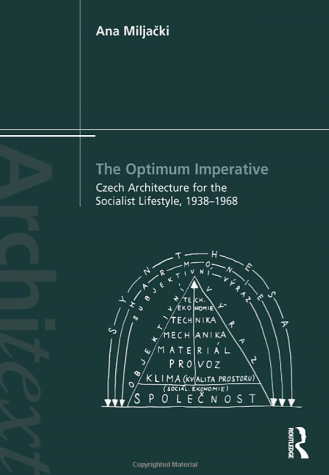Ana Miljački
Routledge, 2017

In an epoch when it is less difficult to fathom the end of the world than the end of capitalism (per Fredric Jameson), it is more valuable than ever to revisit a place and time when architects, planners, and intellectuals strove to imagine a different kind of society and, for a period, successfully contributed to its construction. Ana Miljački’s The Optimum Imperative: Czech Architecture for the Socialist Lifestyle, 1938–1968 covers three turbulent decades in Czechoslovakia’s mid-twentieth-century history, offering a detailed chronicle of events and an informed and sophisticated analysis of the evolution of Czech architectural culture.
Interwar Czechoslovakia was a parliamentary democracy and Prague was a hub of avant-garde experimentalism until 1938, when Nazi forces occupied the country and annexed the Sudetenland. After Germany’s defeat in 1945, Czechoslovakia briefly regained its independence, but three years later, amid heightening Cold War tensions, an internal coup by the Czech Communist Party, backed by the Soviet Union, brought it into line with the East European bloc and imposed the Stalinist diktat of socialist realism. Another decade on, in the thaw ushered in by Khrushchev, Czech architects enjoyed an interlude of liberalization and relative aesthetic freedom. This came to an abrupt halt in 1968 with the crushing of the Prague Spring by Warsaw Pact troops and the restoration of a regime of “normalization.” The latter would prevail until the Velvet Revolution of 1989, when communism finally collapsed in Czechoslovakia, as it did elsewhere in Europe.
Through the twists and tribulations of this dramatic history, Czech architecture underwent a series of institutional reconfigurations and engaged in a number of original intellectual debates. Under communism—and as framed by the leading architect Karel Honzík (1900–1966) and other protagonists in his circle—Czech architectural discourse revolved around the forging of a new socialist “lifestyle” based on a revisionist interpretation of earlier utilitarian functionalism and a more contextualized, environmentally inflected conception of modernist form. The translation of the Czech word život as “lifestyle” seems a little ironic in this context given that the English word has been more familiarly associated (especially since the 1950s and in light of Frankfurt School theory) with Western–style consumer culture. However, as Miljački persuasively elaborates, this trope underwrote Czech architects’ efforts to formulate both a more rational and a more humanistic alternative to the materialism of a market-based society and to arrive at a “reasonable” compromise between needs and desires in a collective society.
Miljački devotes a good deal of attention to institutional history, tracing the massive reorganization and consolidation of the Czech architectural profession and building research institutes under the aegis of the state agency Stavoprojekt starting in 1948. Subsequently, during the reform years, Stavoprojekt was transformed into a more decentralized network of differentiated, regionally based offices. While such history does not always make for scintillating reading (here or in general), it led to the emergence in the late 1960s of the office SIAL in the city of Liberec, established by the architects Karel Hubáček, Miroslav Masák, and two engineers, and its offshoot Školka studio, which in the late 1960s became ground zero for experimental design work and alternative forms of practice by a new generation of young architects who, as Miljački writes, listened to the rock music of the underground band Plastic People of the Universe as they pursued emancipatory ways of making architecture and living communally.
Combining political, intellectual, professional, and architectural history, Miljački draws on a wealth of material in Czech archives, Czech architectural periodicals, and personal recollections, most of which have remained untapped by Western historians to date. In translating numerous passages from original sources and reproducing a rich selection of visual material, she performs a substantial service, contributing to ending the radio silence that Cold War–era work from Eastern Europe has suffered for seven decades and reinforcing parallel recuperations by other recent scholars in relation to former communist states.
Of equal importance to her work of scholarly excavation, Miljački’s intelligent analysis opens up a new context for thinking about theoretical issues that are still very much with us today, despite our very different experience. Among these are the nature of authorship and the preconditions for creativity in architecture; the fate of humanistic design in a society of advanced technological production; the contradictions between aesthetics and politics; the agency and historicity of architectural avant-gardes; and the modalities of exchange and migration of architectural ideas.
Apropos of this last, while progressive Czech architects could not fail to look over their shoulder at the production of their counterparts in the West during the Cold War—and major international exhibitions like those staged in Brussels in 1958, Moscow in 1959, and Montreal in 1967 offered opportunities for consequential encounters between opposed world systems, as Miljački discusses—they remained resolutely and for the most part optimistically focused on the immediacies of their own society. How to achieve new technical efficiencies and at the same time give Czechoslovakia’s provisionally achieved version of socialism a human face? How to counteract the dullness and alienation of the standardized environment? How to design spaces for free time and leisure so as to enhance the everyday life of all citizens?
Miljački’s account, based on her doctoral dissertation completed at Harvard in 2007, is unsentimental but hardly unsympathetic. By bringing postwar Czech history to the attention of a wider audience she insures that the ghost of idealistic socialism will continue to haunt the architectural imagination. As she notes in her acknowledgments, she grew up the daughter of two Yugoslav architects who designed many of Belgrade’s modern housing estates in the 1970s and 1980s. Those who witnessed so many vicissitudes during the second half of the twentieth century from the far side of the Iron Curtain may be more inclined than others to doubt whether we are truly at the end of history today.
How to Cite this Article: Ockman, John. Review of The Optimum Imperative: Czech Architecture for the Socialist Lifestyle, 1938-1968, by Ana Miljački. JAE Online. March 23, 2018. https://jaeonline.org/issue-article/optimum-imperative-czech-architecture-socialist-lifestyle-1938-1968/.






